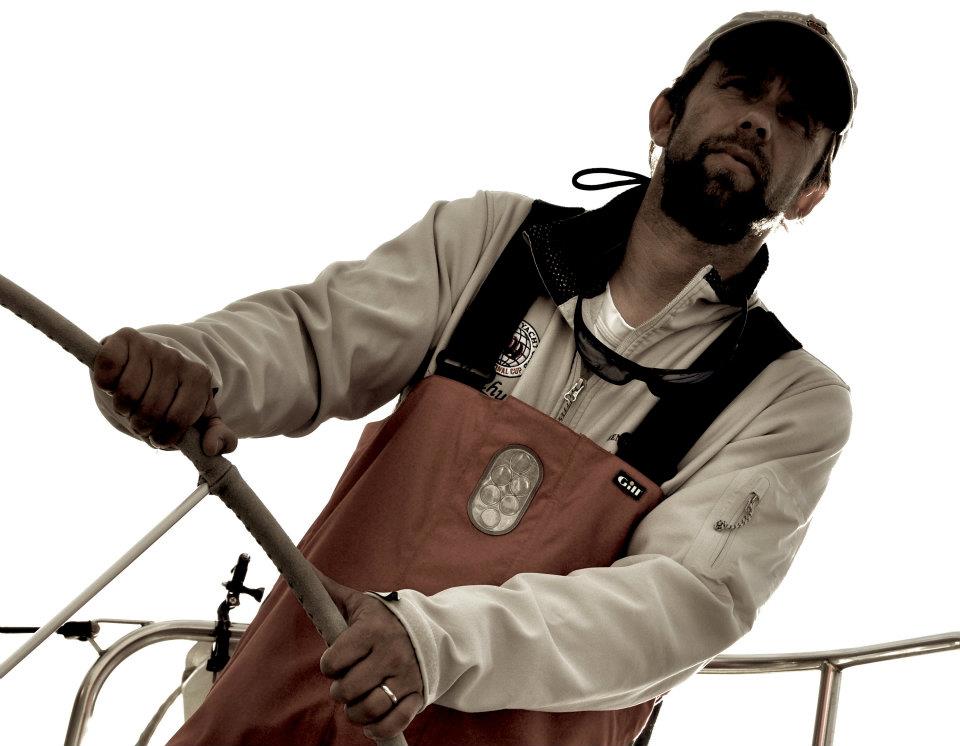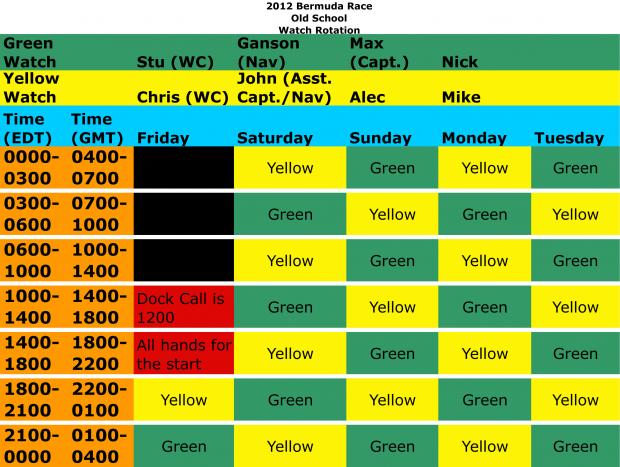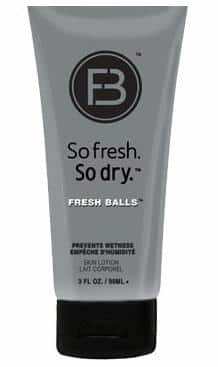
120613_Stu_at_helm
Vol 2: Why?
Why?
It’s a question that surrounds every ocean race. For me it’s been a little more prevalent this time. My daughters (two and four) are asking why I’m going away. And whether they can come. My friends are asking why I’m going on a smaller boat? And then I’m asking myself the same questions, plus plenty more.
My first Bermuda Race, in 2004, was one for the ages. We started in a brisk northerly, chutes flying. We were actually over the line early and had to re-start (wow, was that embarrassing) but from there it was all gravy. We wallowed a bit in a convergence zone the first night, but after that we ran or reached right all the way to Bermuda. We got there in three days, finished third in the Gibbs Hill Lighthouse division, and then partied in Bermuda for two days while all the slower boats fought through glassed-off conditions.

Everyone said: “That was your first? Make it your last. It won’t get that good again.”
For better or worse, I ignored that advice. In 2006, I sailed on an old Volvo 60, a spot I got thanks to my position as an editor at Sailing World. It was slow, mostly upwind. We took nearly five days to finish. And we did poorly.
The common theme in those two races was I was merely a bit player. I did a little time at the helm, but mostly I humped sails, trimmed, manned the pedestal, etc. So when I decided last fall that I really wanted to do the Bermuda Race again, I made a decision. I would trade a bigger, more prestigious ride for one where I could be a key cog in the operation.
That’s just what I’ve found on Ganson Evans’ Farr 395 Old School. I’ll be a watch captain for the race, one of the helmsmen, and I’ve been involved with creating everything from the watch schedule (at left) to the menu. Win, lose, or middle of the fleet, my fingerprints will be all over this effort.
But that doesn’t really answer the question why I’m doing this? Between the start and the finish are at least 635 wet, bumpy miles. After the adrenaline of the start has worn off (that takes about an hour), it’s nearly impossible to stop wondering how many of them you still have left to sail.
What it comes down to is that were I not sailing in this year’s race, I would’ve spent this week feeling desperately envious of everyone participating, longing to feel a little bit of the anxious energy, the excitement, and the anticipation. If the forecast had come in like it has, with a lot of downwind sailing on offer, I would’ve been even more disappointed to be sitting it out. In fact, I would’ve been kicking myself.
Even with the most perfect forecast, there are a lot of hard, tired, damp miles in this race. I’m sure I’ll ask myself more than one occasion, “Why?” And I’ll struggle to find a worthwhile answer. But hopefully there will be as many times where I can look around, check out the stars, or the beauty of an empty ocean, and think, “Man, does it get any better than this?”
Vol. 1: Fresh Balls
******If you’ve done a few hundred nautical miles in the same pair of damp, crusty underwear**—the offshore sailor’s version of walking a mile in his shoes—then you know precisely why I was so excited when a non-sailing friend send me a link to a story about a male grooming product called Fresh Balls (if you think that’s a little cheeky, the name of the company that produces it is Happy Junk, LLC).
While my friends were having a good laugh conjuring up the perfect marketing campaign for this product—a lotion which claims to prevent “wetness and the uncomfortable feelings of being sweaty, sticky, and chafing in the groin area, which all men suffer from”—my mind went in a totally different direction: This is just what I need for the Bermuda Race. Well, that and the fact that Happy Junk LLC should probably spend some more money on its copy editing to avoid dangling prepositions in future ads.
One of the highlights of my journalism career was when I got a honest-to-goodness laugh out of comedian—and novice offshore racer—Stephen Colbert by explaining to him about the Gold Bond Handshake. This takes place when an offshore sailor, after dusting off his privates with some baby powder—Gold Bond being a popular brand—comes on deck and either shakes hands, high fives, or pats on the back a fellow crew member, leaving behind a telltale white residue that could be quite innocuous except for the fact that there’s only one reason why anyone’s hand would be covered with white powder.
All kidding aside, the Gold Bond routine is a subject of vigorous debate amongst offshore sailors. Some swear by it, others won’t touch it, often citing the fact that once you start, you’ve basically committed yourself to a regular powder shower for the rest of the race.
I’ve generally found myself in the former group. Though I’ve held off as long as possible. It’s far from a perfect solution, often the lesser of two evils. Maybe Fresh Balls is the better mousetrap. I’ll find out soon enough.
A big part of the thrill of distance racing is the build up. Buoy-racing regattas seem to arrive like a fast-moving rainsquall. One minute it’s over the horizon, out of sight and mind, the next you’re in the midst of it. Then next minute, it’s all over, and you’re back at work.

Offshore races creep up, with the excitement and intensity gradually building to a fever pitch (and then, of course, you start, and usually settle into hour upon hour of ennui). Part of this is due to the sheer logistics of preparing for a long offshore race. It takes weeks, if not months, to get everything in order: crew, safety training, safety equipment, food, sails, boat preparation, etc. It’s a seemingly endless list. And for many crews the preparation probably could go on forever were it not for one thing: At a designated time, we all have to cross the starting line and start sailing. So during the final week we scramble to get our boats and ourselves ready. I’m sure some boats are organized enough to have a relaxed final week. Most are not, which is OK with me since during the last few days before a distance race it’s really hard to focus on anything else.
The anticipation for the 2012 Bermuda Race really started to build on Monday, four days before Friday’s afternoon start (1 p.m. off Castle Hill Light, a class every 10 minutes). I generally don’t place much stock in long-range forecasts, but once we’re inside of five days, I’ll generally take a look to see what they’re saying, albeit with the understanding that it’s little more than a guess in many cases. With each day that passes, the forecast becomes a little more reliable.
This year, the forecasters have been predicting since Monday a moderate to fresh northeasterly breeze for Friday and Saturday. The strength has varied. Some days they’ve called for 10 to 15 knots. Right now they’re expecting a little bit more, 15 to 20. With the rhumb line to Bermuda bearing approximately 149 degrees, this could mean a downwind start, and a quick trip to the Gulf Stream, or some point even closer to the Dark N’ Stormys at the Royal Bermuda YC bar.
The thought of a sunny downwind start, spinnakers flying, and the boats pointed down the rhumb line is enough to get any distance racer’s heart beating. Visions of records for the big boats, and fun, downwind sailing for all involved are pretty enticing.
However, sailing that good rarely comes without a price. In our case, as a friend reminded me a day ago, the debt could come due to crossing the Gulf Stream where 4 to 5 knots of current work against 15 to 20 knots of breeze, which could create some extreme conditions that will test sailors, boats, and sails.
And even the most benign distance race will involve a fair amount of discomfort. It’s part of the deal. Which is why distance sailors, like myself, obsess over anything that will improve their experience just a little bit. It could be the perfect piece of waterproof gear, the right meal, a new bit of hardware for the boat, a comfortable hat for the first night watch, or, in this case, the ultimate solution for skin chafe.









